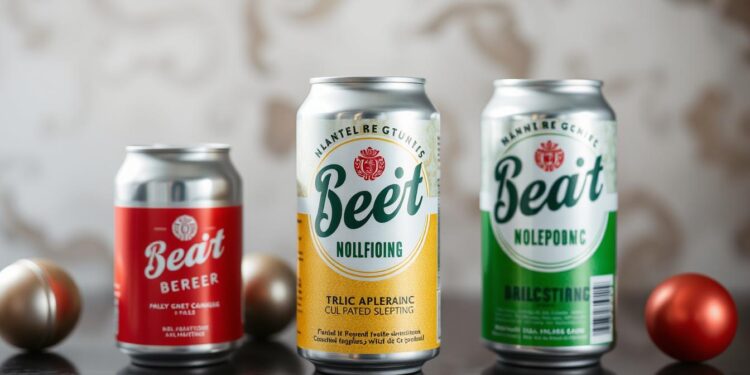Non-alcoholic beer is becoming more popular, offering a fun alternative to regular beer. The main difference is in alcohol content. Non-alcoholic beers have less than 0.5% alcohol, while regular beers can have up to 12%.
Brewers are finding new ways to make non-alcoholic beers taste like the real thing. They use special techniques to get the flavor and smell right.
Key Takeaways
- Non-alcoholic beers contain less than 0.5% alcohol by volume, while alcoholic beers range from 2% to 12% ABV.
- The four main ingredients used in non-alcoholic beer production are water, grains, hops, and yeast.
- Controlled fermentation is the most common method of producing non-alcoholic beers, where the process is stopped before alcohol production concludes.
- Dealcoholization, involving the removal of alcohol from a liquid, is another method used in non-alcoholic beer production.
- Non-alcoholic beer production continues to evolve with new techniques expected to emerge as the popularity of non-alcoholic beer grows.
Ingredients of Non-Alcoholic Beer
Non-alcoholic beer is made with the same basic ingredients as regular beer. These are water, grain, hops, and yeast. Water is the biggest part of beer, grains give sugar for yeast to turn into alcohol, hops add bitterness and flavor, and yeast makes the beer ferment.
Some breweries add spices and other ingredients to make their non-alcoholic beer special. This makes each brand unique.
The non-alcoholic beer market has grown a lot lately. Bars now sell non-alcoholic beers faster than their regular ones. This is because more people want to drink less alcohol or are health-conscious.
Non-alcoholic beer usually has less than 0.5% ABV. This is like the alcohol in vanilla extract or ripe bananas.
The brewing process for non-alcoholic beer is different. It uses special techniques to keep the alcohol low. This can include special yeast, adjusting how it ferments, or removing alcohol with methods like vacuum distillation or reverse osmosis.
The end result is a drink that tastes and smells like beer but doesn’t make you drunk.
“Any reduction in alcohol intake, including consuming non-alcoholic beer, can benefit health. Non-alcoholic beer generally has fewer calories and sugar than full-strength beer or non-alcoholic alternatives like soft drinks.”
How is Non-alcoholic Beer Made
Non-alcoholic beers are made in four main ways: controlled fermentation, dealcoholization, dilution, or simulated fermentation. These methods help brewers keep the taste of beer without the alcohol.
The controlled fermentation method carefully controls the fermentation to limit alcohol. This is often used by small craft breweries. Lallemand’s LalBrew® LoNa™ strain and Escarpment Labs’ NAY yeast are special yeasts for making low-alcohol and non-alcoholic beers.
Dealcoholization, like vacuum distillation or reverse osmosis, is used by big producers. It removes alcohol precisely but needs a lot of money, hard for small breweries.
Dilution and simulated fermentation are also used. Dilution lowers alcohol by adding water. Simulated fermentation mimics brewing without actual fermentation.
The recipe and how it’s made decide the beer’s look, smell, and taste. As the no- and low-alcohol category grows, new brewing ways are coming up. They aim to offer tasty, alcohol-free beers.
Dealcoholization Process
The making of non-alcoholic beer often includes a step called dealcoholization. This process reduces the alcohol content a lot. It’s key for those looking for a fun, alcohol-free drink.
Vacuum distillation is the main way to do this. It makes alcohol boil at a lower temperature. This lets the alcohol be removed without changing the beer’s taste too much.
Other methods like membrane filtration and reverse osmosis are also used. Membrane filtration separates alcohol, color, and flavor from the beer. Then, the alcohol is added back in. Reverse osmosis uses high pressure to remove water and alcohol, keeping the beer’s taste.
These dealcoholization and alcohol removal methods have helped non-alcoholic beer get better. As more people want alcohol-free drinks, brewers keep finding new ways to make great non-alcoholic beers.
Other Non-Alcoholic Beer Production Methods
There are many ways to make non-alcoholic beer, besides dealcoholization. Brewers are trying new methods like controlled fermentation, dilution, and simulated fermentation. These approaches help create low- or no-alcohol drinks.
Controlled fermentation, or “arrested fermentation,” is one method. It lets the beer ferment like regular beer but stops before it gets too alcoholic. This way, the beer’s original taste stays more intact. Special yeast strains are being developed for non-alcoholic beer production, offering unique flavors and aromas that are harder to achieve with other methods.
Dilution is another method. Brewers add water to the finished, alcoholic beer to lower the alcohol. This method keeps more of the beer’s natural taste compared to some dealcoholization techniques.
Simulated fermentation skips fermentation altogether. It uses ingredients and enzymes to mimic fermentation’s effects. This no fermentation brewing method, which involves withholding yeast to the wort, results in a 0.00% brew. It’s often used in Islamic countries where alcohol is banned.
The non-alcoholic beer industry is growing fast. These new production methods are becoming more popular. They let brewers offer more choices and meet the needs of health-conscious drinkers.
The Rise of Craft Non-Alcoholic Beer
The non-alcoholic beer market has seen a big change in recent years. What was once limited to a few options, now craft beer has entered this space. Brewers are making non-alcoholic beer that’s flavorful and appealing.
Younger people, like Gen Z, are driving the demand for non-alcoholic beer. Craft breweries are responding with a variety of styles. They offer everything from light IPAs to rich stouts, meeting the needs of health-conscious and light drinkers.
Big names like Sierra Nevada and Deschutes Brewery are leading the way. They use new technologies to make top-notch non-alcoholic beers. Sierra Nevada uses a special yeast to keep the alcohol low. Deschutes Brewery has teamed up with Sustainable Beverage Technologies to create its non-alcoholic line, winning awards at big competitions.





